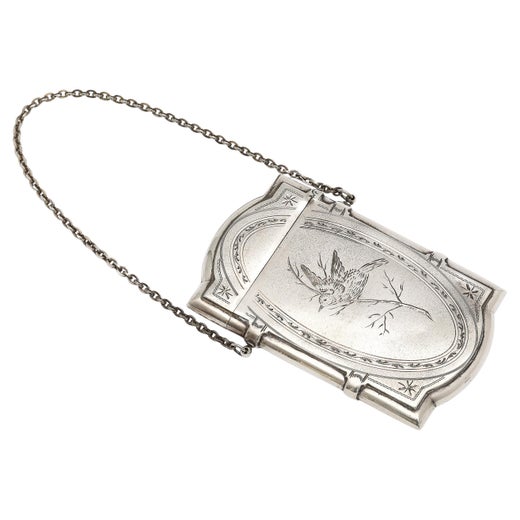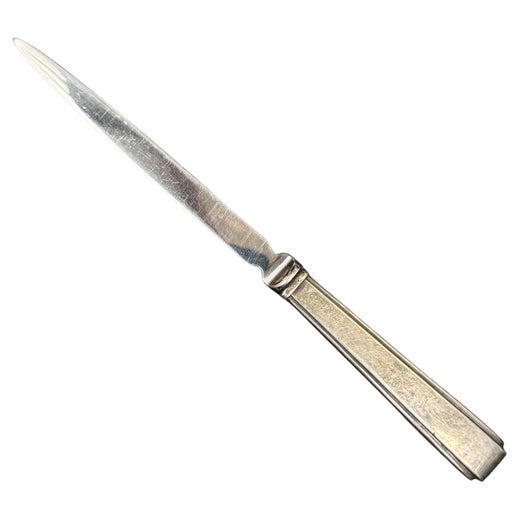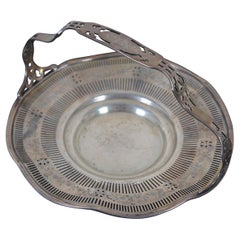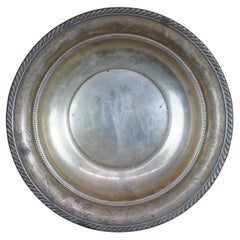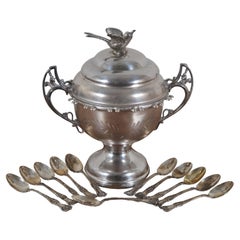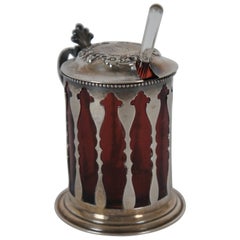4 Antique Sterling Souvenir Spoons Gorham Lunt Mechanics Missouri Columbia
About the Item
- Creator:
- Dimensions:Height: 0.25 in (6.35 mm)Width: 5.75 in (14.61 cm)Depth: 1.25 in (3.18 cm)
- Sold As:Set of 4
- Style:Victorian (In the Style Of)
- Materials and Techniques:
- Period:
- Date of Manufacture:Late 19th Century
- Condition:Wear consistent with age and use. Good Overall - Tarnish/gentle wear.
- Seller Location:Dayton, OH
- Reference Number:Seller: 360371stDibs: LU5343231644562
Gorham Manufacturing Company
For nearly 160 years, the Gorham Manufacturing Company turned out a wide range of beautiful silver flatware, tea sets, serving bowls and other silver pieces, indelibly influencing the field of decorative arts in ways that still resonate.
When silversmiths Jabez Gorham and Henry Webster started making coin silver teaspoons and jewelry out of a small workshop in Providence, Rhode Island, in 1831, the pair likely had no idea that their modest operation would one day become the largest silver manufacturer in the world.
While some name changes and personnel shifts preceded the foundry officially being established as Gorham Manufacturing Company decades later, growth of the business between its early days and the mid–19th century can largely be attributed to the work of Jabez’s son John, who assumed control of Gorham in the 1840s.
John Gorham introduced steam power at the manufactory. He entered into a partnership with Michael Gibney, the first American silversmith to register a design patent for a flatware pattern. Gorham wanted to expand the business, seeking to produce forks and spoons adorned with decorative flourishes adapted from British patterns. The company hammered out the silver flatware, which it sent to Gibney in New York to apply decorative patterns before returning to Gorham. Consequently, Gorham found Gibney’s work unsatisfactory, and he purchased his own rolling press to do the work himself.
The partnership between John and Michael soured but the company thrived. Sales grew to more than $20,000 per year, and the staff of silversmiths expanded. To keep up with demand, Gorham had to retire its horse-powered rolling press and import a steam-powered drop press from England — the first used in the United States. Designs created at Gorham drew on natural-world motifs as well as artistic traditions from all over the world — alongside its tableware, the company would soon be producing cups and pitchers adorned with polar bears and forest creatures, while tea services and other serving pieces were crafted in a range of styles that included Art Nouveau, Egyptian Revival and Rococo.
Around 1860, Gorham delved into bronze casting. When it opened a division dedicated to bronze work, Gorham collaborated with sculptors such as Daniel Chester French, Anna Hyatt Huntington and Alexander P. Proctor.
By the 1920s, Gorham had employed thousands of workers and had partnered with Danish modernist silversmith Erik Magnussen. However, the Great Depression ground production to a halt. The company was sold to Textron, Inc. in the late 1960s and it changed hands several times before it sold to Department 56 in 2005.
Today, the work of Gorham Manufacturing Company continues to be exhibited in galleries and museums. The RISD Museum in Providence houses a collection of nearly 5,000 works.
On 1stDibs, find a range of antique Gorham Manufacturing Company serveware and decorative objects.
Lunt Silver
Founded in the early 20th century, Lunt Silversmiths became a celebrated domestic designer and producer of flatware, hollowware, serveware and giftware for generations, remaining in Lunt family hands for more than 100 years. It was the oldest continuously operating family-owned silver company in the United States.
Lunt Silversmiths was incorporated in Greenfield, Massachusetts, in 1902 as Rogers, Lunt & Bowlen Company. The firm succeeded A. F. Towle & Son Co. — later Towle Silversmiths — purchasing its tools, machinery, trademarks and goodwill. Lunt was originally managed by George E. Rogers, president and major investor; George Colby Lunt, treasurer and general manager; and William Caldwell Bowlen, vice president and supervisor of manufacturing until his retirement in 1929. George C. Lunt and William C. Bowlen were both qualified members of the staff of the defunct Towle's factory.
On April 4, 1912, the founders of Rogers, Lunt & Bowlen Company registered the manufacturer’s trademark at the federal level. In 1935 the company name was shortened to Lunt Silversmiths. In 1957 Lunt Silversmiths acquired King Silver Co. and its subsidiary Richard Dimes Company of South Boston, MA.
Lunt Silversmiths had in its inventory a wide array of flatware patterns such as Alexandra, American Directoire, Modern Victorian, Belle Meade, Carillon, Charles II, Chased Classic, Chatelaine, Colonial Manor, William and Mary, Contrast, Delacourt and many more. The United States government chose Lunt’s Embassy Scroll pattern (1981) as its official tableware in all U.S. embassies and consulates around the world.
In late 2009 Lunt sold its brand and inventory to Reed & Barton. The following year all remaining manufacturing and inventory assets at the Greenfield factory were sold at auction.
Find antique Lunt sterling silver flatware and other furnishings and decorative objects on 1stDibs.
(Biography provided by Schear Brothers)
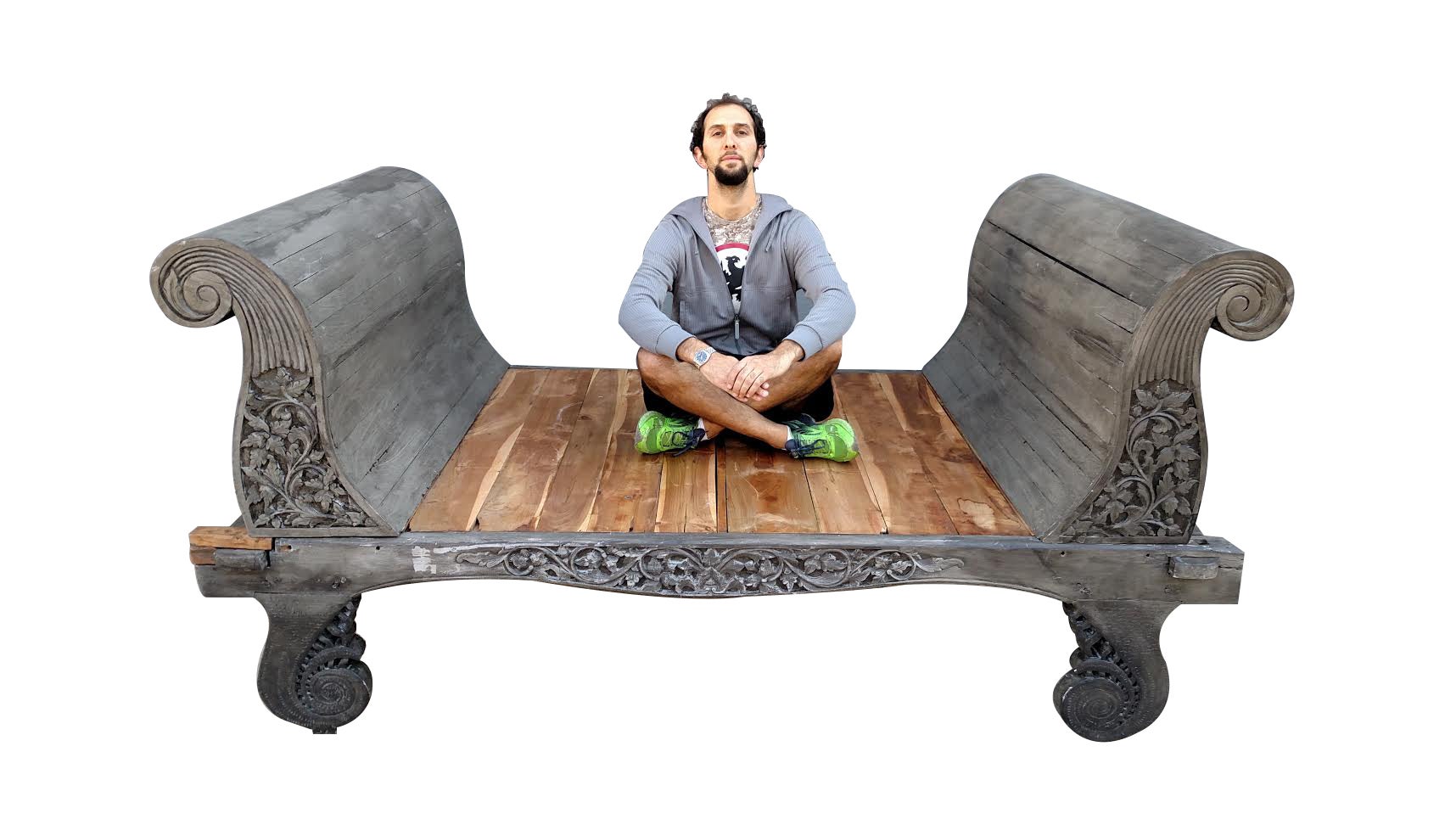
You May Also Like
Vintage 1970s Sterling Silver
Sterling Silver
Mid-20th Century Tableware
Sterling Silver
20th Century Tableware
Sterling Silver
Mid-20th Century Tableware
Sterling Silver
20th Century Tableware
Sterling Silver
20th Century Tableware
Sterling Silver
20th Century Sterling Silver
Sterling Silver
Antique Late 19th Century Tableware
Sterling Silver
20th Century Tableware
Sterling Silver
Late 20th Century Tableware
Sterling Silver
More From This Seller
View AllEarly 20th Century Edwardian Sterling Silver
Sterling Silver
Early 20th Century Sterling Silver
Sterling Silver
Early 20th Century Late Victorian Serving Pieces
Metal, Sterling Silver
Antique Late 19th Century Victorian Sterling Silver
Sterling Silver
Antique 1870s Art Nouveau Sterling Silver
Sterling Silver
Vintage 1910s Edwardian Sterling Silver
Sterling Silver
